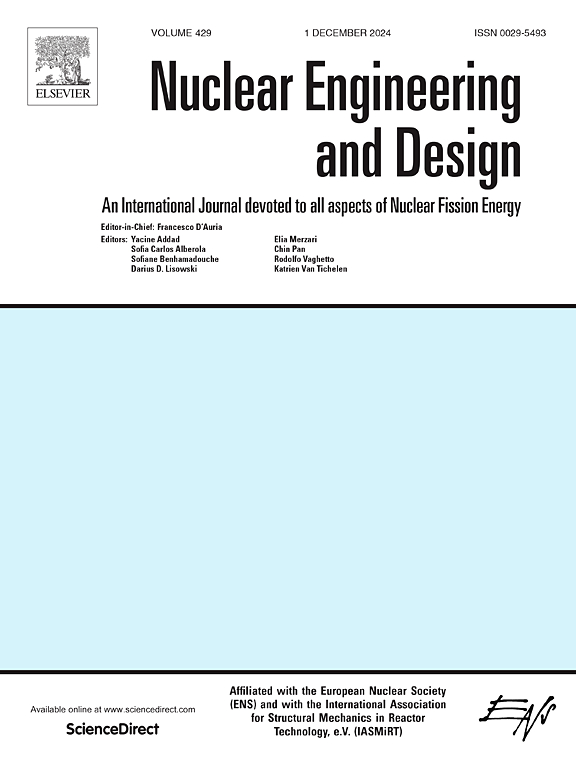液态金属快堆多支撑筒内流固耦合评价
IF 2.1
3区 工程技术
Q1 NUCLEAR SCIENCE & TECHNOLOGY
引用次数: 0
摘要
在液态金属快堆(LMFR)中,支撑筒是保证反应堆稳定性和安全性的关键结构部件。在地震等极端条件下,液态金属冷却剂会显著影响支撑缸的附加质量,改变其模态频率和振动响应。以往对快堆流固耦合的研究主要集中在刚性容器内的晃动效应。然而,现有的部分浸没的、耦合的、包含三维效应的lfrs气缸系统模型还存在空白。基于位流理论,建立了多缸系统的简化流固耦合(FSI)数学模型,并采用广义单自由度(SDOF)系统对支撑缸的动态特性进行了仿真。通过实验和数值结果的对比,验证了该模型在多种构型下的精度,误差在5%以内。本文考察了水位变化、柱体间距、高径比和形状函数选择对附加质量计算的影响。为了提高计算精度,提出了有限长圆柱的三维修正公式。结果表明:随着水位的升高和圆柱间距的减小,附加质量系数增大,而高径比对附加质量的影响呈非线性;本文的研究工作为低阻堆支撑筒结构的抗震设计和安全性评价提供了理论分析和实验验证。本文章由计算机程序翻译,如有差异,请以英文原文为准。
Evaluation of Fluid-Structure interaction in multiple support cylinders of a liquid metal fast reactor
The support cylinder in a Liquid Metal Fast Reactor (LMFR) is a critical structural component essential for ensuring reactor stability and safety. Under extreme conditions, such as earthquakes, the liquid metal coolant significantly affects the added mass on the support cylinder, changing its modal frequency and vibration response. Previous research on the fluid–structure interaction of fast reactors mainly focused on the sloshing effect in rigid vessels. However, there is a gap in existing models for partially submerged, coupled cylinder systems in LMFRs that incorporate three-dimensional effects. This paper introduces a simplified fluid–structure interaction (FSI) mathematical model for a multi-cylinder system, based on potential flow theory, and employs a generalized single-degree-of-freedom (SDOF) system to simulate the dynamic characteristics of the support cylinder. By comparing experimental and numerical results, the model’s accuracy is validated with an error within 5% across multiple configurations. The paper examines the effects of water level changes, cylinder spacing, height-to-diameter ratio, and shape function choice on the added mass calculation. A three-dimensional correction formula for finite-length cylinders is proposed to improve calculation accuracy. The results show that the added mass coefficient increases with higher water levels and smaller cylinder spacing, while the height-diameter ratio has a nonlinear effect on added mass. This work provides a theoretical analysis and experimental verification of the FSI in LMFR support cylinders, which is important for the reactor’s seismic design and safety evaluation.
求助全文
通过发布文献求助,成功后即可免费获取论文全文。
去求助
来源期刊

Nuclear Engineering and Design
工程技术-核科学技术
CiteScore
3.40
自引率
11.80%
发文量
377
审稿时长
5 months
期刊介绍:
Nuclear Engineering and Design covers the wide range of disciplines involved in the engineering, design, safety and construction of nuclear fission reactors. The Editors welcome papers both on applied and innovative aspects and developments in nuclear science and technology.
Fundamentals of Reactor Design include:
• Thermal-Hydraulics and Core Physics
• Safety Analysis, Risk Assessment (PSA)
• Structural and Mechanical Engineering
• Materials Science
• Fuel Behavior and Design
• Structural Plant Design
• Engineering of Reactor Components
• Experiments
Aspects beyond fundamentals of Reactor Design covered:
• Accident Mitigation Measures
• Reactor Control Systems
• Licensing Issues
• Safeguard Engineering
• Economy of Plants
• Reprocessing / Waste Disposal
• Applications of Nuclear Energy
• Maintenance
• Decommissioning
Papers on new reactor ideas and developments (Generation IV reactors) such as inherently safe modular HTRs, High Performance LWRs/HWRs and LMFBs/GFR will be considered; Actinide Burners, Accelerator Driven Systems, Energy Amplifiers and other special designs of power and research reactors and their applications are also encouraged.
 求助内容:
求助内容: 应助结果提醒方式:
应助结果提醒方式:


